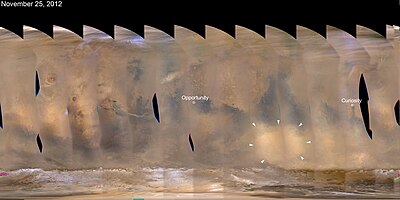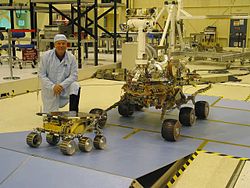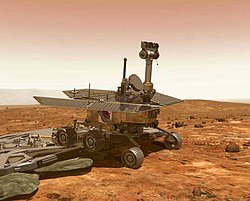PIA22329-Mars-DustStorm-20180606
This global map of Mars shows a growing dust storm as of June 6, 2018. The map was produced by the Mars Color Imager (MARCI) camera on NASA's Mars Reconnaissance Orbiter spacecraft. The blue dot shows the approximate location of Opportunity.
The storm was first detected on June 1. The MARCI camera has been used to monitor the storm ever since.
Full dust storms like this one are not surprising, but are infrequent. They can crop up suddenly but last weeks, even months. During southern summer, sunlight warms dust particles, lifting them higher into the atmosphere and creating more wind. That wind kicks up yet more dust, creating a feedback loop that NASA scientists still seek to understand.
Malin Space Science Systems, San Diego, provided and operates MARCI. NASA's Jet Propulsion Laboratory, a division of Caltech in Pasadena, California, manages the Mars Reconnaissance Orbiter for NASA's Science Mission Directorate, Washington. Lockheed Martin Space Systems, Denver, built the spacecraft.Relevante Bilder
Relevante Artikel
OpportunityOpportunity war ein US-amerikanischer Erkundungsroboter zur geologischen Erforschung des Mars, der von 2004 bis 2018 aktiv war. Die Sonde wurde von der NASA am 7. Juli 2003 im Rahmen des Mars-Exploration-Rover-Programm gestartet. Sein ursprünglicher Name lautete deswegen auch Mars Exploration Rover B (MER-B) und wurde dann später in Opportunity geändert. .. weiterlesen
Staubsturm (Mars)Staubstürme auf dem Mars erreichen durch die dünne Marsatmosphäre hohe Windgeschwindigkeiten um die 100 km/h, allerdings nur einen geringen Winddruck. Ihre Intensität ist also viel geringer als die von Stürmen auf der Erde. Sie können sich jedoch über große Flächen ausdehnen und sogar den gesamten Planeten einhüllen. .. weiterlesen










































